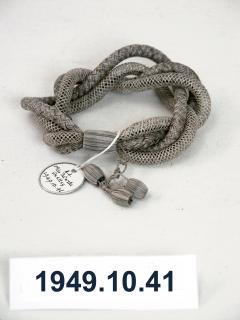
1949.10.41 Bracelet made from Mrs Farrer's plaited and netted grey hair in January 1867. Donated by Pastorella Shelley.
Victorian society, at least from the 21st century perspective, appears to have been excessively governed by formal rules of etiquette. This was as true for matters relating to death as with all other areas of social life. Richardson [1989: 106] comments that:
'... the Victorian celebration of death was largely about show - about the conspicuous consumption of what we now view as a dubious good. Death provided the Victorians an opportunity for making public statements about social worth which were, more often than not, in fact largely about monetary value. .... The Victorian era was one with an obsessive interest in the gradations of social placing; and death served as a prime means of expressing, and of defining, social place.'
In Victorian England customs and traditional practices helped to distinguish a 'good death' from a bad one, and to ensure that what followed was seemly and according to accepted behaviour. A good death was generally considered to be the true end of a Christian life, with the promise of eternal life to follow:
'A Good Death meant dying peacefully in your own bed, surrounded by family and friends, with a clergyman on hand to administer the Last Rites and your children brought in to kiss you goodbye. Elaborate Victorian customs eased the transition from deathbed to the final resting-place of the grave, from natural sleep to the sleep of death. A Good Death meant the opportunity for famous last words ... The worst fate was to die alone.' [Arnold, 2007: 182]
Attitudes to death in England have changed considerably since Victorian times. Where once it was commonplace and acceptable to wear ornaments made from the enduring parts of relatives' corpses (that is, hair) it has come to seem unsavoury. [Hallam & Hockey, 2001: 4] We have now generally become more squeamish about death, we are much less likely to view the bodies of even close relatives once they are dead when once it would have been expected that neighbours and friends, as well as relatives, would have visited the corpse before interment.
All cultural values are relative and shift over time and space, but in relation to death some of these values may change greatly over relatively small periods of time, or short distances. Even today, for example, the relationship the English have with the dead is different from that experienced in Scotland or Ireland. This web page examines only those practices and artefacts relating to death in and artefacts from England. Death is an event which like most life crises, is most likely to be associated with religion. For this reason many of the artefacts dealt with in these web pages relate to items relate to Christian burial practices. The Museum does not currently have an artefacts in its English collections that relate to other religion's death related customs.
Death-related artefacts from England in our collections can be loosely divided into the following categories:
Note:
Many of the other artefacts associated with death in the Pitt Rivers Museum from England are from graves and were dug up during archaeological excavations. I will not consider these here, except to note that in many cultures in the world, and over time, people have been buried with items which will either be useful to them in the afterlife, or which were particularly meaningful during their lives. Although some people still follow this custom today our English ethnographic items, understandably, do not contain any such items.
[ texts in purple are not quoted within site, but are useful references ]
The Pitt Rivers Museum has many objects in its collections that are related to the subject of death from all over the world, including England. Indeed there are several displays devoted to this subject, in the Court of the Museum (ground floor), namely:
Case 7.A - Treatment of the Dead - Ancient Egypt, Peru and Chile
Case 122.A - Treatment of the Dead
Cases 130 A and B, 131.A and B - Treatment of Dead Enemies
However, these displays do not, in general contain relevant artefacts from England.
There are also artefacts related to death in the lower gallery (first floor):
Case 41.A - Body Arts - Dressing the Dead
Case 41.B - Body Arts - Death and Mourning
This second case does display several mourning ornaments made in England from human hair.
Most of the items relating to death in the Pitt Rivers Museum English collections were made or acquired during Victorian times, the zenith of the period when English people most closely grappled with the issues and customs relating to death. Although these collections are not extensive, they are diverse and interesting and cover most aspects that make this subject of abiding interest to many scholars. It would be interested to collect this type of object today in contemporary England where most people prefer not to think of death unless it is unavoidable, and avoid artefacts related to funerals and, most particularly, to dead bodies. It is likely that this public attitude will change again over time, indeed it may be that events such as the reaction to the death of Diana, Princess of Wales, in 1997 may indicate that change is already underway. The recent advent of memorial internet sites, and 'green' funeral may indicate more change.